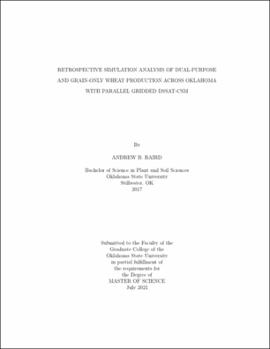| dc.contributor.advisor | Alderman, Phillip D. | |
| dc.contributor.author | Baird, Andrew B. | |
| dc.date.accessioned | 2023-09-21T18:57:20Z | |
| dc.date.available | 2023-09-21T18:57:20Z | |
| dc.date.issued | 2021-07 | |
| dc.identifier.uri | https://hdl.handle.net/11244/339598 | |
| dc.description.abstract | Wheat grain and forage production is an important aspect of many Oklahoma wheat management systems. Given the high interannual variability in rainfall and temperature conditions during the wheat season, agricultural producers and post-harvest processors would benefit from information regarding how these factors interact with soil properties to affect wheat production within different regions over time. The overall goal of this study was to assess the ability of the parallelgridded version of the CROPSIM-CERES-Wheat within the Decision Support System for Agrotechnology Transfer Cropping Systems Model to capture wheat production patterns in wheat grain yield and forage biomass within Oklahoma wheat production systems over space and time. Gridded simulations of winter wheat growth and development were run for 20 seasons (1997-2017) across Oklahoma at a 5-km resolution. Two production systems (grain-only and dual-purpose) and two genotypes (Tam 101 and Jagger) were used for simulation. The 20 year simulated average yield was typically higher than both NASS and Oklahoma Wheat Variety trial yield data. Correlation of grain yield to cumulative season rainfall shows that yield typically goes up when the cumulative rainfall is high. Dual-purpose grain estimates performed similarly to grain-only, however end of season forage biomass estimations performed poorly for all years. Maturity date was reported by the model earlier in the southern part of the wheat belt varied from 120 to 150 days after planting. | |
| dc.description.abstract | The introduction of a spatially diverse temporal data set including weather data spanning 1997 to 2018 from the Oklahoma Mesonet, paired with wheat variety trial data spanning 1999 to 2018, as well as soil data from SSURGO. The database is a robust combination of genetic information such as yield from over 100 wheat genotypes,soil, weather, and management. The resulting data structure provides detailed insight on wheat production across Oklahoma over roughly 20 years, into a single condensed dataset that has potential to be used for crop simulation modeling and exploring the effects of genotype, environment, and management interactions (G x E x M). In total there are 391 WHA files, 60 WHT files, 425 weather files, and 1 soil file as a bi-product to be used in future analysis. | |
| dc.format | application/pdf | |
| dc.language | en_US | |
| dc.rights | Copyright is held by the author who has granted the Oklahoma State University Library the non-exclusive right to share this material in its institutional repository. Contact Digital Library Services at lib-dls@okstate.edu or 405-744-9161 for the permission policy on the use, reproduction or distribution of this material. | |
| dc.title | Retrospective simulation analysis of dual-purpose and grain-only wheat production across Oklahoma with parallel gridded DSSAT-CSM. | |
| dc.contributor.committeeMember | Kakani, V. Gopal | |
| dc.contributor.committeeMember | Silva, Amanda de Oliveira | |
| osu.filename | baird_okstate_0664M_17288.pdf | |
| osu.accesstype | Open Access | |
| dc.type.genre | Thesis | |
| dc.type.material | Text | |
| thesis.degree.discipline | Plant and Soil Sciences | |
| thesis.degree.grantor | Oklahoma State University | |
